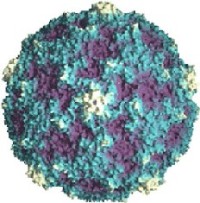Enteroviruses are a large genus of viruses within a much larger family of viruses called the picornaviruses (Picornaviridae) of which the polio viruses are the best known. Our Enterovirus Research focuses on a group of the enteroviruses called the group B coxsackieviruses (CVB), which have been shown to be causes of numerous minor as well as serious human diseases, including aseptic meningitis, myocarditis, pancreatitis, and myositis.
The Enterovirus Research laboratory began its work on the biology of the group B coxsackieviruses (CVB, serotypes 1-6 or CVB1-6) and the role of these viruses in the causation of human myocarditis more than 25 years ago under the direction of Drs. Steve Tracy and Nora Chapman (now Emeritus Professors). The laboratory cloned infectious complementary DNA (cDNA) copies of three different CVB3 RNA genomes to enable manipulation of the viral genomes1-3. The cloning of an RNA virus genome captures a specific genome in DNA form, which is less prone than the virus population itself to change genetically. Thus, by using such infectious cDNA clones, we are able to always refer to a specific nucleotide sequence with a good degree of confidence, and introduce specific mutations to study their effects on virus biology.
Current research interests include virus adaptations (evolution), including the ability to bind cell-surface molecules in addition to the active CVB receptor, CAR, and mutations that affect virus stability, in response to environmental pressures.
We have assembled and characterized a library of different CVB strains for study. There are six serotypes of CVB, called CVB1-6. Serotypes differ primarily on the basis of how the immune system of the mouse or human recognizes the virus; otherwise, the CVB1-6 are quite similar. Within any serotype, there are near myriad strains or variants of the virus. We have used the CVB3 serotype predominantly as our model system and we have derived molecular clones of several CVB3 genomes.


